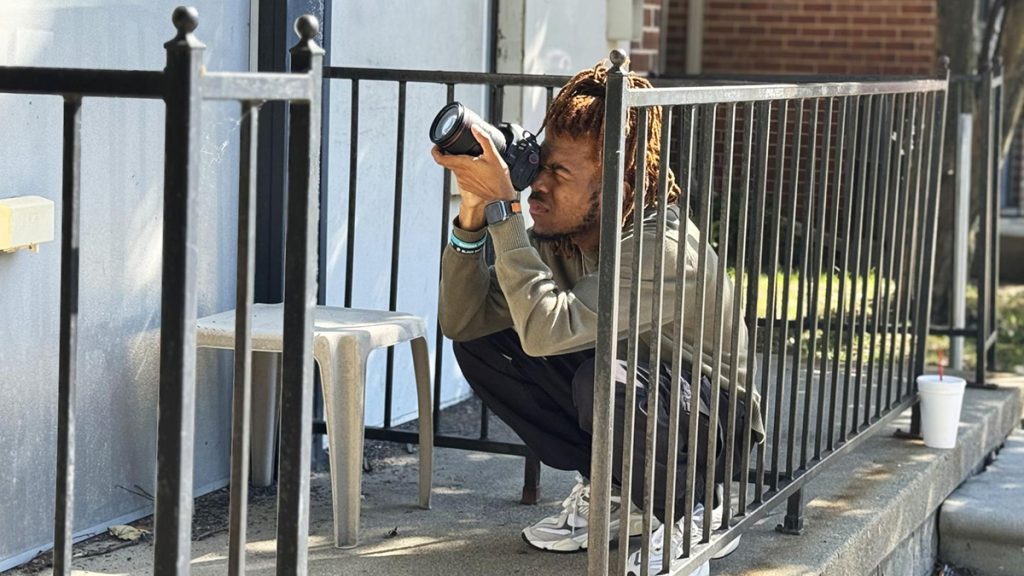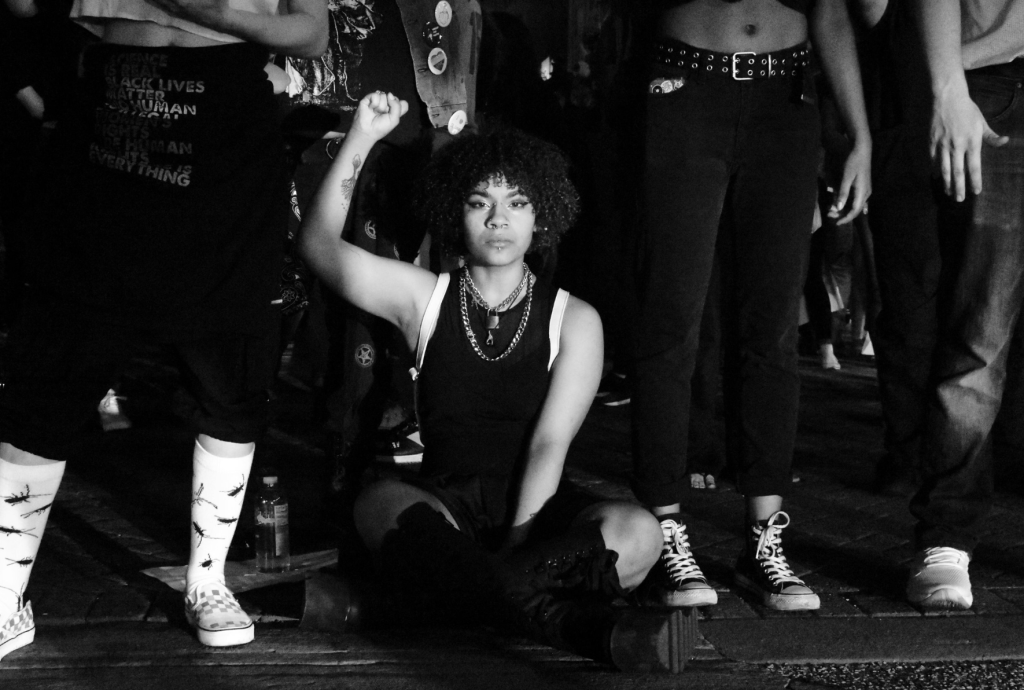
Jacob Wooten, Outlier Media's 2024 summer photojournalist intern, works on assignment at the Foundation First Childcare Development Center in Detroit on Wednesday, June 12, 2024. Wooten’s images illustrated a story about the high cost of child care in Detroit. Photo: Cydni Elledge | Outlier Media
Building equitable freelance contracts
Maintaining copyright is key to photojournalists’ sustainability
Most U.S. publications rely on freelance visual journalists to illustrate original reporting.
Offering plain-spoken contracts provides clarity, protection and accountability for both parties. This can lead to more trust and long-term relationships, which lessens the burden on newsrooms to constantly train new people. And equitable terms — particularly those that allow freelancers to retain copyright and that ensure timely payment — enable sustainable livelihoods for contractors.
“You end up with better journalism,” Elisabet Cantenys, the Executive Director of A Culture of Safety Alliance (ACOS), said. “Individuals that feel cared for — whether a freelancer or a staffer — perform better. They are more committed.”
Through its contracts resource, ACOS helps media companies and freelance journalists agree to contract terms that protect the interests and safety of freelance journalists. They also offer and assemble resources around legal assistance, safety training and digital security on their site.
Contracts enable freelance journalists to make informed decisions about their work for publications, Cantenys said. “If I’m aware of what I’m signing and what this contract is lacking, that empowers me in a way,” she said. “I might not be able to negotiate outside of the terms I’m given, but at least I’m aware of what I’m walking into.”
In addition to the ACOS contract resource, small and low-resource newsrooms can develop contributor contracts by tapping into free legal consultation through Lawyers for Reporters, TrustLaw or the European Pro Bono Alliance.
In this article, we offer guidance on several aspects of fair contracts that cultivate fair working conditions between publications and freelancers through language around copyright, payment, safety and contractor status.
Please note that the information contained in this article is provided for informational purposes only and should not be construed as legal advice on any matter. Consult an attorney for legal advice.
Image rights
Prior to the internet, publications typically licensed contractor images for a set period of time and within a specific context. Modern journalism business models have made that impractical.
Nonprofit newsrooms cannot realistically be expected to remove all images from websites and social media after a set period of time, nor to stop sharing articles and images with other publications, a practice that increases reach and amplifies reporting.
It’s a common misconception that news organizations need to own exclusively, or “buy out,” the copyright to images created by freelancers. Newsrooms may need a liberal license to use freelancer content, but language that strips copyright from creators — like “Work for Hire” — can limit a photographer’s ability to make a living by licensing images elsewhere.
If publications require broad licenses or full buy-outs to specific sets of images, then they should be prepared to pay higher assignment rates.
“Photographers are creating an asset that can be profitable for the corporation,” documentary photographer Vanessa Charlot said. “It should be equally profitable for the image maker.”

Charlot, who is also an Assistant Professor of Media and Communication at The University of Mississippi, encourages young photographers to understand the value of their work. This is ensured, she said, by turning down contracts that give publications free rein to use their work or that restrict their ability to license images elsewhere.
“We love being photojournalists, covering stories, doing this important work,” she said, but “it’s still a business. You have to think about how you are going to sustain it.”
Equitable contracts start with the photographer maintaining copyright. Contracts most favorable to creators will license works for one story or for a limited period of time, but publications sometimes choose to offer contracts that license images in perpetuity (forever) or that share copyright with photographers. Publications should consider how they are profiting in comparison to how the photographer is being compensated, both immediately and in the long term.
To ensure images aren’t licensed elsewhere before the original reporting is published, publications may want to add an exclusivity or “embargo” period for set periods of time, like 72 hours or seven days after publication. These periods are negotiable, and publications may want to ask for longer embargo periods for long-form work.
Contractor status and livable rates
Historically, the majority of images published in newspapers were made by staff photojournalists. Today, full-time photographer positions are rare, even at national newspapers.
Standard freelance contracts outline the non-employee status* of contractors. This means freelancers do not receive benefits and steady paychecks like staff reporters and editors. They also are not furnished with camera, lighting, computer equipment, software or insurance, which can cost anywhere between $5,000 and $20,000 and are necessary to complete assignments. This high cost of doing business can drive out freelancers from low-resource backgrounds and can hurt a publication’s ability to hire journalists who reflect the communities they cover.
Assignment rates should reflect:
- The copyright agreement (higher for a copyright buyout)
- A region’s cost of living
- The length of time required to complete an assignment (including meetings and editing)
- The frequency of work
For context: In a city like Chicago, the average assignment rate is around $250. National newspapers pay between $400 and $500 per assignment with an increase up to $900 for a long day. It should be noted that industry surveys, like the State of Photography 2022, reveal that financial precarity is common among freelance photojournalists.
*Editorial note: For publications hiring photographers who work in California, the 2020 law AB5 classifies some independent contractors as employees.
Payment terms
For assignments that require travel, freelancers are often expected to front hundreds if not thousands in expenses. This is another barrier to entry for early-career and under-resourced photojournalists.
Publications should do everything they can to ensure that freelancers are paid within 30 days of submitting their invoice, and for assignments that require larger expenses like hotel rooms and flights, they should offer to pay such expenses up front when possible.
Here’s an example of a Payment Terms agreement via ACOS that we feel is fair to both parties:
In consideration for the Contributor’s creation of the Works, the Company shall pay to the Contributor a[n] [daily][hourly] fee of $_____ payable for Works (the “Publication Fee”). The Contributor agrees to submit an invoice that includes a reasonably detailed description of the [days][hours] worked…and the Company agrees to pay the Publication Fee determined pursuant to such invoice within [thirty (30) days] of receiving such invoice.
Legal, digital and physical safety
Visual reporting requires time spent in the field, engaging with individuals and communities. This can come with hazards, and newsrooms should offer the same risk-mitigation training and protections to freelancers that staff members receive. They should also create plans to offer support should a freelancer become unsafe due to their reporting. This can include an injury on assignment, which may limit a freelancer’s ability to make a living, or an online threat.
Publications should consider offering subscriptions for freelancers to information security products like DeleteMe. They should also include freelancers in their general liability insurance and media liability insurance, which covers a variety of IP-related lawsuits.
And finally, publications often require freelancers to represent and warrant in contracts that the work is original and does not infringe copyright or violate any other rights. To promote equity in contracts, newsrooms should otherwise avoid requiring freelancers to indemnify the publisher should the publication be sued for something related to a story. If they must require an indemnification clause, let it be a mutual indemnification, in which both parties agree to compensate the other party for damages arising from a breach of contract.
Cite this article
Kanaar, Michelle; and Schukar, Alyssa (2024, Nov. 5). Building equitable freelance contracts. Reynolds Journalism Institute. Retrieved from: https://rjionline.org/news/building-equitable-freelance-contracts/
